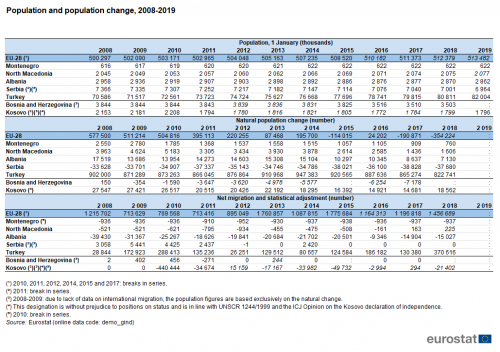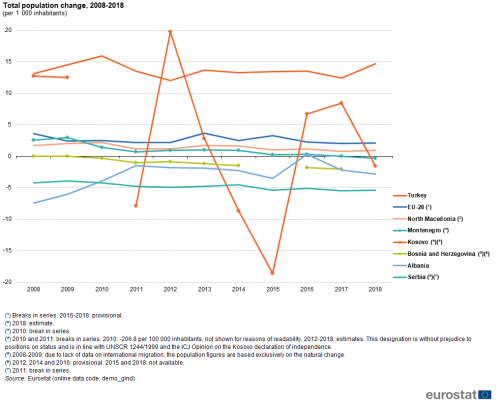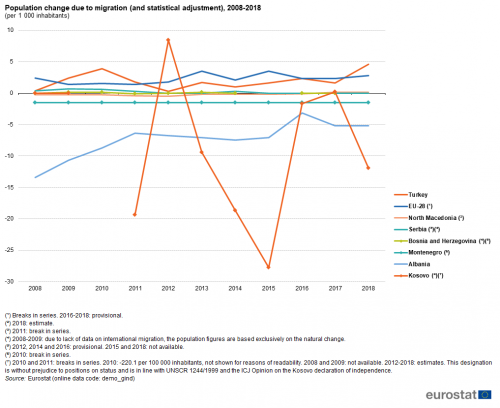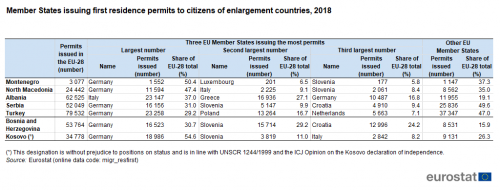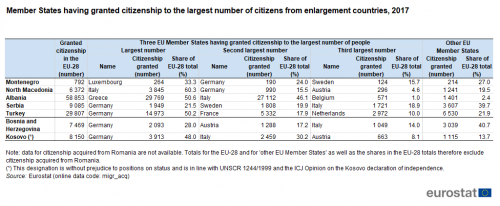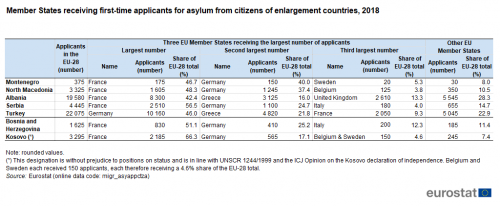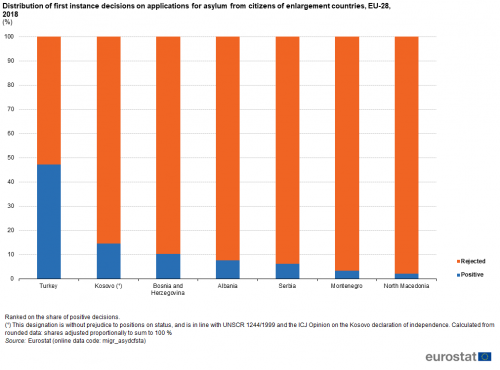Archive:Enlargement countries - statistics on migration, residence permits, citizenship and asylum
Data extracted in October 2019.
Planned article update: October 2020.
Highlights
The number of Montenegrins having received a first residence permit in the EU-28 in 2018 was more than four times the number in 2008, while for citizens of Kosovo the number had more than trebled and for citizens of Bosnia and Herzegovina it had more than doubled.
In 2017, 58 853 Albanians were granted citizenship of an EU Member State, principally in Greece (50.6 %) or Italy (46.1 %).
The number of first-time asylum applicants in the EU-28 from Albanians was 31.8 times as high in 2018 as it had been in 2008.
While 15.0 % or fewer of first instance decisions in 2018 on applications from citizens of six of the enlargement countries were positive, almost half (47.2 %) of all decisions of this type relating to citizens of Turkey were positive.
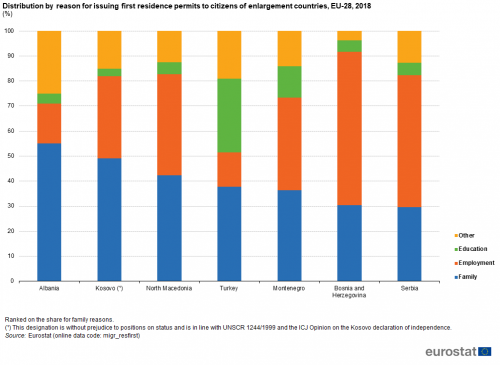
(%)UNIT
Source: Eurostat (migr_resfirst)
This article is part of an online publication for the European Union (EU) enlargement countries, in other words the candidate countries and potential candidates. Montenegro, North Macedonia, Albania, Serbia and Turkey currently have candidate status, while Bosnia and Herzegovina and Kosovo ( ) are potential candidates.
The article starts with an overview of the size of the population in each of the enlargement countries in order to provide background to the subsequent indicators: at the beginning of 2019, the population of Turkey was 4.6 times as large as the population of all of the other enlargement countries combined (including 2018 data for Bosnia and Herzegovina), 11.8 times as large as that of the next largest enlargement country (Serbia) and 132 times as large as that of the smallest one (Montenegro).
The article looks at changes in the size of the population of the enlargement countries due to two factors: natural change from births and deaths on one hand and migration on the other. It then focuses on citizens of enlargement countries living within the EU-28, presenting information for residence permits issued to them and their acquisition of citizenship of an EU Member State. It concludes with information concerning citizens of enlargement countries having applied for asylum in the Member States.
Full article
Population change: natural change and net migration
There were approximately 513 million persons resident in the EU-28 on 1 January 2019 (see Table 1). The combined population of the enlargement countries was 100 million inhabitants, which was equivalent to slightly less than one fifth (19.4 %) of the EU-28 total. Turkey was by far the most populous enlargement country, with 82 million inhabitants in 2019, just smaller than the population of Germany (83 million), but larger than the population of any other EU Member State. By contrast, Montenegro was the smallest enlargement country in population terms, with 622 thousand inhabitants, somewhat smaller than the population of Cyprus (876 thousand), but larger than those of Luxembourg (613 thousand) or Malta (494 thousand).
The development of the number of inhabitants within the enlargement countries followed a varied pattern between 1 January 2008 and1 January 2019. The population of Turkey increased at a relatively rapid pace, growing by 16.2 % overall during the period under consideration, while the number of inhabitants in North Macedonia and Montenegro grew at a modest pace, increasing by 1.6 % and 1.1 % respectively; this was slower than the corresponding rate of change in the EU-28, where the size of the population grew by 2.6 % overall. Elsewhere, there were relatively large declines in the populations of the enlargement countries: down 3.2 % in Albania, 5.5 % in Serbia (note that there is a break in series), 8.9 % in Bosnia and Herzegovina (1 January 2008 to 1 January 2018), and 16.6 % in Kosovo (note that there is a break in series).
The overall change in population from one year to the next reflects the combined effects of natural population change and net migration (the latter including statistical adjustment). The natural population change is the balance between the number of births and the number of deaths. Net migration is the balance between the number of immigrants and the number of emigrants. Net migration figures are calculated by taking the difference between total (overall) population change and natural change: the difference is referred to as net migration plus statistical adjustment. The statistics on net migration plus statistical adjustment are therefore affected by any statistical inaccuracies in the two components (total and natural population change).
In 2018, deaths outnumbered live births in the EU-28 (for the second consecutive year), resulting in a natural decrease in the population of 354 thousand people. The overall increase in population recorded during 2018 for the EU-28 was therefore due to positive net migration and statistical adjustment. In 2018, net migration and statistical adjustment accounted for an increase of almost 1.5 million persons, more than in 2016 and 2017 (both 1.2 million); since 1992, net migration and statistical adjustment has been the main determinant of population growth in the EU-28.
Among the enlargement countries, Serbia as well as Bosnia and Herzegovina stood out as they were the only ones that, like the EU-28, had a higher number of deaths than births, resulting in a negative natural population change. Other than in 2008 in Bosnia and Herzegovina, this situation was observed in both of these enlargement countries for all of the years shown in Table 1.
Concerning net migration and statistical adjustment the situation was more complex. Turkey recorded an increase due to migration (and statistical adjustment) in all years, whereas Montenegro, North Macedonia and Albania recorded a decrease in every year from 2008 to 2018 (other than in 2017 and 2018 in North Macedonia). Kosovo recorded a negative value for net migration and statistical adjustment most years, with positive values in 2012 and 2017; note that there are breaks in series in 2010 and 2011 and the particularly large negative value recorded for 2010 probably reflects a large statistical adjustment. For Serbia and for Bosnia and Herzegovina, data are not available for the most recent years: every year for which data for Kosovo are available (2008-2011 and 2014) a population increase due to migration was recorded; for Bosnia and Herzegovina a similar situation was observed, with increases between 2008 and 2010 and again in 2013, with one negative value recorded in 2011.
Crude rates of change are calculated by relating a change in absolute terms during a year to the average population for that year, with the result expressed per 1 000 inhabitants. Figures 1 and 2 show two crude rates of change, one for the overall change in population and the other for net migration and statistical adjustment: data are not shown for Serbia, Bosnia and Herzegovina, or Kosovo due to the short or interrupted time series.
Among the enlargement countries shown in Figure 1, Turkey had the highest rate of population change every year from 2008 to 2018, reflecting increases generally between 12 and 16 per 1 000 inhabitants. Furthermore, in every year shown in Figure 1, Turkey recorded a faster population growth than did the EU-28, as was also the case for Montenegro in 2009. By contrast, in every year between 2008 and 2018 the EU-28 recorded population growth that was higher than that recorded in North Macedonia and Albania. In every year, Albania recorded the largest negative crude rates of population change among the enlargement countries, sharing this position with Montenegro in 2016.
Figure 2 shows the crude rate of population change from migration and statistical adjustment. It can be compared directly with Figure 1 as it has the same scale. Notably the rate of change from migration and statistical adjustment for Turkey was much lower than it was for the population as a whole. Nevertheless, Turkey still recorded the fastest population increases due to migration among the enlargement countries in all years, although in most years this rate of change was lower for Turkey than it was for the EU-28. In the years between 2008 and 2018, the largest population decreases due to migration and statistical adjustment were in Albania (which had a negative rate every year). Montenegro also recorded negative rates in every years while North Macedonia did in every year from 2008 to 2016.
First residence permits issued
Some of the people who emigrate from enlargement countries move to EU Member States and are issued with residence permits. The first part of the analysis concerning residence permits focuses on the number of first residence permits issued during a year, in other words the number of permits issued to new residents in the Member States. In general, this figure excludes renewals of existing permits, but a residence permit is also considered to be a first permit if the time gap between the expiry of an old permit and the start of validity of the new permit issued for the same reason is at least six months.
Table 2 shows that 310 000 first residence permits were issued in 2018 by EU Member States to citizens of enlargement countries, the largest number during the period from 2008 to 2018 and an increase of 28.6 % compared with 2017. As such, around one tenth (9.6 %) of all first permits issued by Member States in 2018 were issued to citizens of enlargement countries. One quarter (25.6 %) of the first residence permits issued by EU Member States to citizens of enlargement countries were issued to citizens of Turkey, one fifth (20.2 %) to Albanians, just over one sixth to citizens of Bosnia and Herzegovina (17.3 %) and Serbia (16.8 %), just over one tenth (11.2 %) to citizens of Kosovo and smaller shares to citizens of North Macedonia (7.9 %) and Montenegro (1.0 %).
Comparing the situation in 2018 with that in 2008, the number of first residence permits issued to Albanians had fallen, while elsewhere it had risen. The number of Montenegrins having received a first permit in 2018 was more than four times the number in 2008, while for citizens of Kosovo the number had more than trebled and for citizens of Bosnia and Herzegovina it had more than doubled.
Germany issued the largest numbers of first residence permits for citizens of six of the enlargement countries, the exception being for citizens of Albania who were more likely to have received a first residence permit from Italy or Greece — see Table 3. The concentration of first residence permits that were issued in Germany was highest for Montenegrins and citizens of Kosovo as Germany alone issued more than half of all such permits issued in the EU-28 to citizens of these two countries. Slovenia, Italy and Croatia also appeared multiple times in the top three Member States issuing first residence permits to citizens of enlargement countries. For citizens of Bosnia and Herzegovina, the top three issuing Member States — Germany, Slovenia and Croatia — accounted for 84.1 % of all first residence permits issued in the EU-28, the highest collective share accounted for by the top three issuing Member States recorded by any of the enlargement countries. The same three Member States were also the top three issuing Member States for citizens of Serbia, but their collective share was 50.4 % of first residence permits issued in the EU (the lowest share recorded among the enlargement countries).
Among the 310 000 first residence permits issued in 2018 to citizens of enlargement countries, two fifths (40.2 %) were for family-reasons, one third (33.4 %) for employment, one tenth (10.8 %) for education and 15.5 % for other reasons (including international protection, residence without the right to work (for example, pensioners), or people in the intermediate stages of a regularisation process). As can be seen from Figure 3, the reasons for which first permits were issued varied somewhat between the enlargement countries. Whereas more first permits were issued for family reasons than for any other particular reason in four of the enlargement countries, this was not the case for citizens of Montenegro, Serbia or Bosnia and Herzegovina where the most common reason was employment: in fact, in 2018 a majority of first permits were issued for employment reasons for citizens of Serbia and of Bosnia and Herzegovina.
Year-end stock of residence permits
The next part of this analysis continues the focus on residence permits, but looks at the stock of all valid residence permits (not just first residence permits) at the end of each year. As of the end of 2018, there were 4.25 million valid permits held by citizens of the enlargement countries to reside in the EU Member States. This was 0.8 % more than one year earlier (at the end of 2017) and 6.5 % more than 10 years earlier (at the end of 2008). As such, citizens of enlargement countries held one fifth (20.0 %) of all the valid residence permits held in the EU-28 at the end of 2018 by citizens of non-member countries, approximately double the share of first residence permits issued to citizens of enlargement countries during 2018. The share of all valid residence permits held by citizens of non-member countries that were held by citizens of enlargement countries fell by 5.4 percentage points between 2008 and 2018.
More than two fifths (44.7 %) of the valid permits held at the end of 2018 by citizens of enlargement countries were held by citizens of Turkey, one fifth (20.6 %) by Albanians, around one tenth by citizens of Serbia (11.6 %) and Bosnia and Herzegovina (9.7 %) and smaller shares by citizens of Kosovo (7.6 %), North Macedonia (5.1 %) and Montenegro (0.7 %).
Comparing the situation at the end of 2018 with that at the end of 2008, the number of valid permits held by Serbian and Turkish citizens had fallen by 26.3 % and 1.6 % respectively, while the number held by citizens of other enlargement countries had risen. The number of citizens of Kosovo holding valid residence permits at the end of 2018 was nearly eight times the number at the end of 2008, while for Montenegrins the number was3.6 times as high.
For six of the enlargement countries the largest number of valid residence permits held by their citizens was recorded in Germany, the exception being for citizens of Albania who were more likely to hold a valid residence permit from Italy or Greece — see Table 5. This pattern was the same as observed for first residence permits issued during 2018 (see Table 3). The concentration of valid residence permits in Germany was highest for citizens of Turkey, Montenegro and Kosovo as more than half of all of the permits held by citizens of these three countries across all of the EU Member States were from Germany. Austria and Italy also appeared multiple times in the top three Member States where citizens of enlargement countries held valid residence permits at the end of 2018.
The top three Member States — Italy, Greece and Germany — which had the largest number of Albanians holding valid residence permits at the end of 2018, collectively accounted for 95.8 % of valid permits held by Albanians in the EU-28, the highest collective share accounted for by the top three Member States recorded by any of the enlargement countries. Collectively, Serbian citizens in Germany, Austria and Italy accounted for 76.9 % of valid permits held by Serbian citizens in the EU-28 (the lowest share recorded among the enlargement countries).
Among the 4.25 million valid residence permits held by citizens of enlargement countries at the end of 2018, just over two fifths (41.2 %) were for family-reasons and one tenth (10.5 %) for employment. As education accounted for just 1.2 % of the valid permits, the remaining 47.1 % had been issued for other reasons. As such, comparing Figures 3 and 4, it can be seen that the shares of valid permits for employment and for education were considerably lower than they were for first residence permits issued during the year.
Acquisition of citizenship
Citizenship of an EU Member State brings new rights and opportunities, such as the rights to move, live and work freely within the EU. During 2017, 121 000 citizens of enlargement countries acquired the citizenship of an EU Member State (excluding Romania), 18.1 % of the number of citizens of all non-member countries who acquired the citizenship of an EU Member State. Nearly half (48.8 %) of the citizens of enlargement countries who acquired the citizenship of an EU Member State were Albanians and nearly a quarter (24.7 %) were citizens of Turkey. Shares below one tenth were recorded for citizens of Serbia (7.5 %), Kosovo (6.8 %), Bosnia and Herzegovina (6.2 %), North Macedonia (5.3 %) and Montenegro (0.7 %).
The number of Albanians who had acquired the citizenship of an EU Member State was 3.5 times as high in 2017 as it had been in 2008, while the number of Montenegrins had more than doubled. Kosovo also recorded an increase in the number of its citizens acquiring the citizenship of an EU Member State, up from 6 600 in 2013 (when the time series starts) to 8 200 in 2017. For citizens of North Macedonia, the number acquiring the citizenship of an EU Member State was slightly lower in 2017 than it had been in 2008 (down 6.8 %). The number of people acquiring citizenship of an EU Member State in 2017 was much lower than in 2008 for citizens of Bosnia and Herzegovina (down 37.5 %), Turkey and Serbia (both down 40.3 %).
In 2017, German citizenship was the one most commonly acquired (among the citizenships of the EU Member States) by citizens of four enlargement countries: Serbia, Turkey, Bosnia and Herzegovina, and Kosovo — see Table 7; note that data are not available for the number of citizens from enlargement countries having acquired the citizenship of Romania. For Montenegrins, the most commonly acquired citizenship among the EU Member States was that of Luxembourg, for citizens of North Macedonia it was that of Italy, while for Albanians it was that of Greece. Italy, Austria and Sweden also appeared multiple times in the top three Member States from which citizens of enlargement countries acquired citizenship during 2017.
Three fifths (60.3 %) of citizens of North Macedonia who acquired the citizenship of an EU Member State in 2017 became Italians, 50.6 % of Albanians who acquired the citizenship of a Member State became Greeks and 50.2 % of Turkish citizens who acquired the citizenship of a Member State became Germans.
Asylum applicants and first instance decisions in the EU
This final section of the article describes recent developments in relation to numbers of asylum applicants in the EU-28 from citizens of enlargement countries as well as decisions on asylum applications. Asylum is a form of international protection given by a state on its territory. It is granted to a person who is unable to seek protection in his/her country of citizenship and/or residence, in particular for fear of being persecuted for reasons of race, religion, nationality, membership of a particular social group, or political opinion.
During 2018, the number of first-time asylum applicants in the EU-28 [1] who were citizens of enlargement countries was 54 720. This was 1.6 % more than one year earlier but 5.5 times as many as 10 years earlier (an increase of 454.1 %). As such, 9.3% of citizens of non-member countries who were first-time applicants for asylum in the EU-28 in 2018 were citizens of enlargement countries. This share was higher than in the previous year (when it was 8.2 %), but less than half the 19.5 % peak share (for the period 2008-2018) recorded in 2010.
Comparing the situation in 2018 with that in 2008, the number of first-time asylum applicants in the EU-28 from Serbia fell, down 17.1 %, while a larger fall (down 66.3 %) was observed between 2009 and 2018 for applicants from Kosovo. By contrast, the number of applicants from citizens of each of the other enlargement countries increased, in all cases greatly. The smallest increases in relative terms were recorded for citizens of Bosnia and Herzegovina and Montenegro, from whom the number of first-time applicants more than trebled, while the number of applicants among citizens of Turkey, North Macedonia and Albania were respectively 7.2, 10.6 and 31.8 times as high in 2018 as they had been in 2008.
Two fifths (40.3 %) of these citizens of enlargement countries who were first-time asylum applicants in the EU-28 in 2018 were Turkish citizens and more than one third (35.8 %) were Albanians. Shares below one tenth were recorded for citizens of Serbia (8.1 %), North Macedonia (6.1 %), Kosovo (6.0 %), Bosnia and Herzegovina (3.0 %) and Montenegro (0.7 %).
Among the EU Member States, the largest number of first-time applicants for asylum in 2018 from six of the enlargement countries were registered in France; the only exception was for citizens of Turkey who were more likely to be first-time applicants in Germany or Greece — see Table 3 — while France was the third most common Member State in which citizens of Turkey were first-time applicants. Germany was the second most common Member State in which citizens of five of the enlargement countries were first-time applicants. As such, France figured among the top three for all of the enlargement countries, while Germany was the first or second most common Member State for first-time applicants from six of the seven enlargement countries, the exception being for Albanian applicants. Greece, Italy, Belgium and Sweden each figured twice among the top three Member States registering first-time applicants from enlargement countries
For first-time applicants from Montenegro in 2018, the top three Member States — France, Germany and Sweden — accounted for 92.0 % of the total number of first-time Montenegrin applicants in the EU-28, the highest collective share for applicants from any of the enlargement countries. By contrast, the share of the top three Member States recording Albanian applicants — France, Greece and the United Kingdom — was 71.7 % (the lowest share recorded for applicants from any of the enlargement countries).
Data on decisions on asylum applications are shown in Figure 5 for first instance decisions. Some applications rejected at first instance may subsequently be accepted in a final decision (after an appeal or review).
In 2018, 51 375 first instance decisions on asylum applications from citizens of enlargement countries were made in the EU Member States; the vast majority (81 %) of these applications were rejected. The largest numbers of first instance decisions were issued for applications from Albanian and Turkish citizens, 36 % and 29 % respectively of the total number of applications in the EU-28 from citizens of the enlargement countries. The share of first instance decisions for applications from citizens of Serbia was 12 %, with smaller shares for citizens of Kosovo (10 %), North Macedonia (8 %), Bosnia and Herzegovina (8 %) and Montenegro (1 %). The proportion of positive first instance decisions was 15 % or lower for applications from citizens of six of the enlargement countries. The exception was applications from Turkish citizens, nearly half (47 %) of which were accepted. As a consequence of this relatively high proportion of positive first instance decisions, applications from Turkish citizens accounted for 71 % of all positive first instance decisions on applications from citizens of the enlargement countries.
Source data for tables and figures (MS Excel)
Data sources
Eurostat provides a wide range of demographic data, including statistics on populations at national and regional level, as well as for various demographic factors influencing the size, the structure and the specific characteristics of these populations. The population data presented in this article were collected from enlargement countries alongside Eurostat’s regular collection of population data from EU Member States and EFTA countries. The data on residence permits, the acquisition of citizenship, asylum and first instance decisions form part of a regular collection of data from Member States and EFTA countries.
Eurostat collects data in its demography data collection exercise in relation to the population as of 1 January each year. The recommended definition is the ‘usual resident population’ and represents the number of inhabitants of a given area on 1 January of the year in question (or, in some cases, on 31 December of the previous year).
Population change in a given year is the difference between the population size on 1 January of the given year and the corresponding level from 1 January of the previous year. It consists of two components: natural change and net migration plus statistical adjustment. Natural population change is the difference between the number of live births and the number of deaths. Net migration is the difference between the number of immigrants and the number of emigrants. In the context of the annual demographic balance, Eurostat produces net migration figures by taking the difference between total population change and natural change; this concept is referred to as net migration plus statistical adjustment.
Data on residence permits are generally based on administrative sources. Commission Regulation (EU) No 216/2010 on Community statistics on migration and international protection, as regards the definitions of categories of the reasons for the residence permits provides the list and definition of reasons for permits being issued. Resident permits statistics are available as both flows and stocks:
- data related to residence permits granted during the reference year (flows) include information about first residence permits issued during the reference year;
- data related to residence permits valid at the end of the reference year (stock of permits) include information about the number of valid permissions to stay at the end of the reference year.
It should be noted that certain methodological aspects are not fully harmonised between the reporting countries due to different legal or information technology systems. See a general article on first residence permits for more information.
Since 2008 data on acquisitions of citizenship have been collected by Eurostat under the provisions of Regulation (EC) No 862/2007 on migration statistics. Citizenship is the particular legal bond between an individual and his or her State, acquired by birth or naturalisation, whether by declaration, choice, marriage or other means according to the national legislation. International law does not provide detailed rules, but it recognises the competence of every state in cases like: spouses of citizens, minors adopted by citizens, descendants of citizens born abroad returning to the country of origin of their ancestors. Countries differ considerably in terms of the conditions to be fulfilled to acquire citizenship: in general a period of legally registered residence is required, combined with other factors such as evidence of social and economic integration and knowledge of national languages. Different conditions may apply for persons who were born in the country concerned (jus soli), or who have parents or other relatives with that country’s citizenship (jus sanguinis). Detailed information on the different modes of acquisition of citizenship in force in different countries can be found at the EUDO Citizenship website.
Equally, data related to asylum have also been provided to Eurostat since 2008, again under the provisions of Regulation (EC) 862/2007. Data are provided with a monthly frequency for asylum application statistics and a quarterly frequency for first instance decisions; data are also collected with an annual frequency for final decisions based on appeal or review, resettlement and unaccompanied minors. These statistics are based on administrative sources and are supplied to Eurostat by statistical authorities, home office ministries/ministries of the interior or related immigration agencies.
An asylum applicant (asylum seeker) is a person having submitted an application for international protection during the reference period or having been included in such an application as a family member. A first-time asylum applicant for international protection is a person having submitted an application for international protection for the first-time in a given EU Member State. The term first-time implies no time limits and therefore a person can be recorded as a first-time applicant only if he or she had never applied for international protection in the reporting country in the past, irrespective of whether or not he or she is found to have applied in another EU Member State.
First instance decisions are decisions granted by the respective authority acting as a first instance of the administrative/judicial asylum procedure in the receiving country.
Tables in this article use the following notation:
| Value in italics | data value is forecasted, provisional or estimated and is therefore likely to change; |
| : | not available, confidential or unreliable value. |
Context
Statistics on population change and the structure of population are increasingly used to support policymaking and provide an opportunity to monitor demographic behaviour within an economic, social and cultural context. Indeed, the EU’s population is ageing as consistently low birth rates and higher life expectancy transform the shape of its age pyramid.
Migration policies within the EU are built upon solidarity and responsibility, taking account of the contribution that immigrants make to the EU’s economic development and performance. Within the European Commission, the Directorate-General for Migration and Home Affairs is responsible for immigration policy. EU policy measures on legal immigration cover the conditions of entry and residence for certain categories of immigrants, such as highly qualified workers subject to the ‘EU Blue Card Directive’, students and researchers, as well as family reunification and long-term residents: see Towards a European agenda on migration for more information.
All relevant legal acts and information regarding the EU’s immigration policy can be accessed on the European Commission’s website.
In May 2013, the European Commission published the EU Citizenship Report 2013 (COM(2013) 269 final). The report noted that EU citizenship brings new rights and opportunities. Moving and living freely within the EU is the right most closely associated with EU citizenship. Given modern technology and the fact that it is now easier to travel, freedom of movement allows EU citizens to expand their horizons beyond national borders, to leave their country for shorter or longer periods, to come and go between EU Member States to work, study and train, to travel for business or for leisure, or to shop across borders. Free movement potentially increases social and cultural interactions within the EU and closer bonds between EU citizens. In addition, it may generate mutual economic benefits for businesses and consumers.
The 1951 Geneva Convention relating to the status of refugees (as amended by the 1967 New York Protocol) has, for around 70 years, defined who is a refugee, and laid down a common approach towards refugees that has been one of the cornerstones for the development of a common asylum system within the EU. Since 1999, the EU has worked towards creating a common European asylum regime in accordance with the Geneva Convention and other applicable international instruments. More information is available in an article on asylum statistics.
Eurostat has the responsibility to ensure that statistical production of the enlargement countries complies with the EU acquis in the field of statistics. To do so, Eurostat supports the national statistical offices and other producers of official statistics through a range of initiatives, such as pilot surveys, training courses, traineeships, study visits, workshops and seminars, and participation in meetings within the European Statistical System (ESS). The ultimate goal is the provision of harmonised, high-quality data that conforms to European and international standards.
Additional information on statistical cooperation with the enlargement countries is provided here.
Notes
- ↑ The EU-28 total is calculated as the sum of data for the EU Member States. Data for each Member State refer to the number of persons applying for asylum for the first-time in that Member State. However, an individual may apply for international protection in more than one Member State in a given reference year. Consequently, the EU-28 total may include such multiple applications by a single person.
Direct access to
See also
- Online publications
- Enlargement countries — statistical overview — online publication
- Statistical cooperation — online publication
- Articles
Publications
- Statistical books/pocketbooks
- Key figures on enlargement countries — 2019 edition
- Key figures on enlargement countries — 2017 edition
- Key figures on the enlargement countries — 2014 edition
- Leaflets
- Basic figures on enlargement countries — 2019 edition
- Basic figures on enlargement countries — 2018 edition
- Basic figures on enlargement countries — 2016 edition
- Enlargement countries — Demographic statistics — 2015 edition
- Key figures on the enlargement countries — Population and social conditions — 2013 edition
Database
- Population change - Demographic balance and crude rates at national level (demo_gind)
- Acquisition and loss of citizenship (migr_acqn)
- Acquisition of citizenship by age group, sex and former citizenship (migr_acq)
- Asylum and Dublin statistics (migr_asy)
- Applications (migr_asyapp)
- Decisions on applications and resettlement (migr_asydec)
- Residence permits (migr_res)
- Residence permits by reason, length of validity and citizenship (migr_resval)
Dedicated section
Methodology / Metadata
- Acquisition and loss of citizenship (migr_acqn) (ESMS metadata file — migr_acqn_esms)
- Applications (migr_asyapp) (ESMS metadata file — migr_asyapp_esms)
- Decisions on applications and resettlement (migr_asydec) (ESMS metadata file — migr_asydec_esms)
- Population change - Demographic balance and crude rates at national level (demo_gind) (ESMS metadata file — demo_gind_esms)
- Residence permits (migr_res) (ESMS metadata file — migr_res_esms)
External links
- European Commission — European Neighbourhood Policy and Enlargement Negotiations
- European Commission — Directorate-General for Economic and Financial Affairs — Demographic developments and projections
- European Commission — Migration and Home Affairs
- European Asylum Support Office — EASO
- UNHCR — Statistics and operational data
